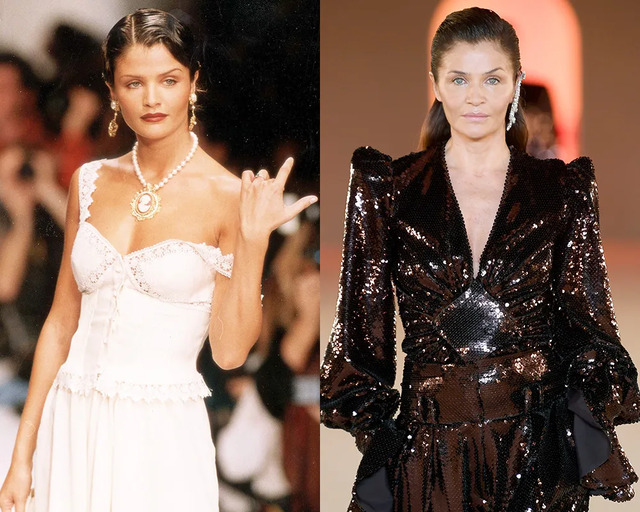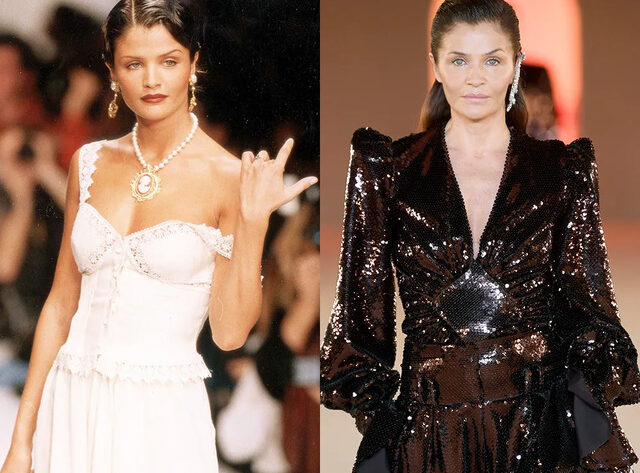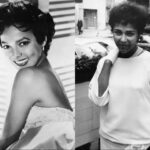Helena Christensen is not just one of the most celebrated supermodels of the 1990s; she embodies the spirit of a Renaissance woman. From dominating international fashion campaigns to launching creative ventures and championing philanthropic causes, Christensen has continually redefined herself while staying true to her values. Her story is one of elegance, innovation, and meaningful impact.
Early Life
Born on December 25, 1968, in Copenhagen, Denmark, Helena Christensen grew up with a unique blend of Danish and Peruvian heritage. Her father, a Danish businessman, and her mother, a Peruvian artist, nurtured her appreciation for culture and creativity. As a child, she pursued ballet, studied multiple languages, and developed an early interest in fashion and beauty.
Her modeling journey began at just 18 years old when she won the title of Miss Universe Denmark in 1986. This victory paved the way for her global exposure at the Miss Universe pageant. Shortly after, she became a finalist in the Look of the Year competition, which led her to Paris and marked the start of her meteoric rise in the fashion world.

Rise to Supermodel Stardom
The 1990s heralded Christensen’s ascent as one of the most iconic supermodels of her era. With her striking green eyes and ethereal beauty, she became a favorite of leading designers and photographers. Her face graced the covers of magazines like Vogue, Elle, and Harper’s Bazaar, while she fronted campaigns for major fashion houses including Chanel, Versace, Prada, and Hermès.
One of her most iconic moments came in 1990 when she starred in Chris Isaak’s music video for “Wicked Game.” The sensual black-and-white video, set on a deserted beach, became a cultural phenomenon, earning recognition as one of MTV’s “Sexiest Videos of All Time.” This moment cemented her status as a global icon.
Christensen also became one of the original Victoria’s Secret Angels, joining a distinguished group of supermodels that included Tyra Banks and Stephanie Seymour. Her association with Victoria’s Secret further solidified her fame and influence in the fashion industry.

Creative Ventures and Business Pursuits
Beyond modeling, Christensen’s creativity found expression in various ventures. In 1999, she co-founded Nylon Magazine, combining her love for fashion and editorial storytelling. As the magazine’s creative director, she played a pivotal role in shaping its distinctive voice and aesthetic, appealing to a new generation of readers.
Her entrepreneurial spirit extended to fashion design. Alongside her close friend Leif Sigersen, she launched the clothing line Christensen & Sigersen. The collection, inspired by vintage aesthetics, gained popularity, and their boutique in New York City’s West Village became a destination for unique fashion finds. Later, she collaborated with lingerie brand Triumph to design elegant collections, showcasing her flair for timeless beauty.
Christensen is also an accomplished photographer. Her work, featured in publications like Marie Claire and Elle, as well as art exhibitions, reflects her depth as an artist. Notable projects, such as her “Far From, Close” exhibition, blend personal storytelling with visual artistry and often support charitable causes.

Philanthropy and Advocacy
Christensen’s commitment to philanthropy is as remarkable as her modeling career. In 2009, she partnered with Oxfam to document the effects of climate change in Peru, her mother’s homeland. Her photography brought global attention to the environmental challenges faced by vulnerable communities.
She is also a passionate advocate for health-related causes. Christensen spearheaded the second Fashion Targets Breast Cancer campaign, raising funds for breast cancer awareness and supporting young women battling the disease. Her ability to leverage her influence for meaningful impact highlights her dedication to creating positive change.

Personal Life
Helena Christensen’s personal life has often captured public interest. In the early 1990s, she had a high-profile relationship with INXS frontman Michael Hutchence, which lasted five years. Later, she was in a long-term relationship with actor Norman Reedus, with whom she shares a son, born in 1999. Christensen has always prioritized her role as a mother, balancing her professional and personal commitments with grace.
Her later relationships included musician Paul Banks of Interpol. Throughout her personal life, Christensen has maintained her dignity and privacy, embodying elegance both on and off the stage. Her homes in Copenhagen, Manhattan, and Catskill reflect her cosmopolitan tastes and love for beauty in all its forms.
Awards and Honors
In 2024, Christensen received the prestigious Women’s Entrepreneurship Day Organization (WEDO) Model Pioneer Award at the United Nations. This honor recognized her groundbreaking contributions to fashion and her dedication to empowering others. Her achievements were also acknowledged by the United States Congress in the Congressional Record, solidifying her legacy as a trailblazer in her field.
Legacy and Influence
Helena Christensen’s influence transcends her supermodel status. She has redefined beauty and success through her creativity, entrepreneurship, and advocacy. Her ability to evolve while staying true to her passions has inspired countless individuals in the fashion industry and beyond.
As a model, entrepreneur, photographer, and philanthropist, Christensen exemplifies the power of combining talent with purpose. Her legacy reminds us that true beauty lies not only in appearances but also in the ability to inspire and create lasting change.
Conclusion
Helena Christensen’s journey from a young girl in Denmark to an international icon is a testament to her talent, resilience, and vision. Whether on the runway, behind the camera, or in the realm of philanthropy, she has consistently broken boundaries and inspired others. Her story reflects timeless elegance and an unwavering commitment to making the world a better place.




